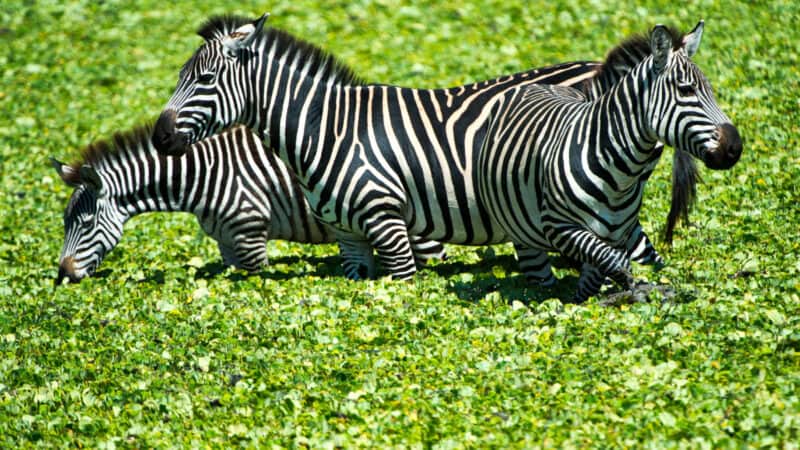Combining Lake Manyara, the Ngorongoro Conservation Area (including the famous Crater), and Tarangire National Park offers a fantastic safari circuit in northern Tanzania, showcasing diverse landscapes and wildlife experiences that complement each other beautifully. Here’s an overview of what each park brings to the itinerary:
Lake Manyara National Park:
- Scenic Introduction: Often the first stop on this circuit, Lake Manyara provides a gentler introduction to Tanzanian wildlife. It’s known for its beautiful alkaline lake, the dramatic backdrop of the Great Rift Valley Escarpment, and diverse habitats ranging from groundwater forests to acacia woodlands and grassy plains.
- Key Highlights:
- Flamingos: The lake often hosts vast flocks of pink flamingos, creating a stunning visual spectacle.
- Tree-Climbing Lions: While sightings aren’t guaranteed, Manyara is famous for lions that have adapted to lounging in the branches of acacia trees.
- Elephant Herds: The park supports a healthy population of elephants, frequently seen close to the lake and within the lush vegetation.
- Birdlife: With over 400 recorded species, it’s a paradise for birdwatchers.
- Compact Diversity: Its varied ecosystems in a relatively small area make for engaging game drives.
- Treetop Walkway: Offers a unique perspective of the forest canopy and its inhabitants.
Ngorongoro Conservation Area (NCA) & the Crater:
- World Wonder: The centerpiece of the NCA is the Ngorongoro Crater, the world’s largest unbroken, unflooded volcanic caldera. It’s a breathtaking natural amphitheater teeming with wildlife.
- Unparalleled Wildlife Density: The crater floor supports an exceptionally high concentration of diverse animals year-round, making for incredible and often close-up wildlife encounters.
- “Big Five” Hotspot: The Ngorongoro Crater offers perhaps the best chance in East Africa to see all members of the “Big Five” (lion, leopard, elephant, rhino, buffalo) in a relatively small area. Black rhinos are particularly well-protected here.
- Stunning Scenery: The panoramic views from the crater rim down to the wildlife-filled floor are simply spectacular.
- Beyond the Crater: The NCA also includes vast highland plains, other volcanic craters, and the important archaeological site of Olduvai Gorge.
- Cultural Interaction: The NCA is a multiple land-use area where the Maasai people traditionally coexist with wildlife.
Tarangire National Park:
- Elephant Kingdom: Tarangire is renowned for its large herds of African elephants, often seen in impressive numbers, especially during the dry season (roughly June to October) when they congregate along the Tarangire River.
- Baobab Trees: The park’s landscape is dotted with majestic baobab trees, adding a unique and iconic element to the scenery.
- Riverine Ecosystem: The Tarangire River is the lifeblood of the park, attracting a high concentration of wildlife, particularly during the dry season.
- Diverse Wildlife: Besides elephants, you’ll find healthy populations of giraffes, zebras, wildebeest, buffaloes, various antelope species (like eland, kudu, and oryx), lions, leopards, cheetahs, and a rich variety of birdlife (over 550 species).
- Less Crowded: Compared to the Serengeti and Ngorongoro, Tarangire often offers a more tranquil and less crowded safari experience, especially outside the peak season.
- Dry Season Spectacle: The dry season in Tarangire is particularly impressive for wildlife viewing as animals gather around the permanent water sources.
The Safari Circuit:
Combining these three parks in an itinerary offers a well-rounded Tanzanian safari:
- Lake Manyara: Provides a gentle and scenic start with diverse habitats and unique wildlife like tree-climbing lions and flamingos.
- Ngorongoro: Delivers a dramatic and highly concentrated wildlife experience within the stunning caldera, offering excellent chances for “Big Five” sightings.
- Tarangire: Showcases massive elephant herds, iconic baobab trees, and a more authentic and less crowded safari atmosphere, particularly rewarding during the dry season.
This circuit typically involves driving between the parks, allowing you to experience the changing landscapes of northern Tanzania. The order of visit can vary depending on your priorities and the time of year. For example, visiting Tarangire during the dry season can be particularly rewarding for elephant sightings.
In essence, a Lake Manyara, Ngorongoro, and Tarangire safari provides a fantastic blend of scenic beauty, unique wildlife adaptations, high concentrations of animals, and diverse ecosystems, making for an unforgettable East African adventure.


